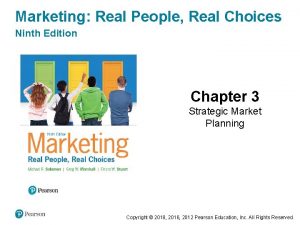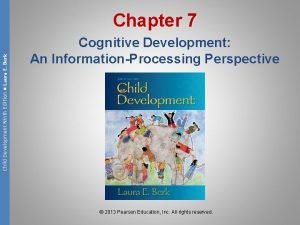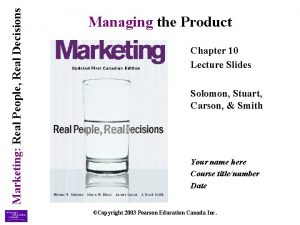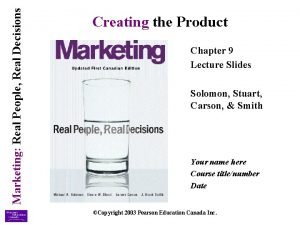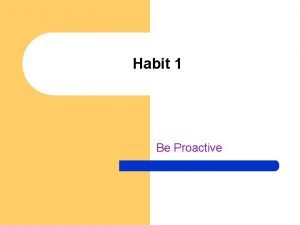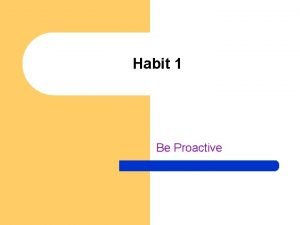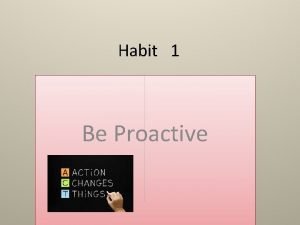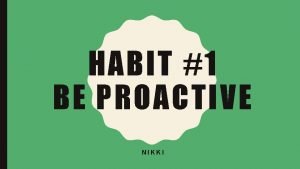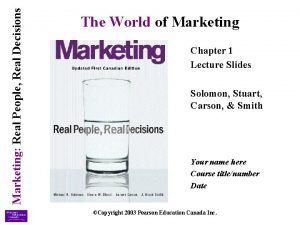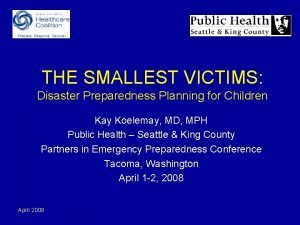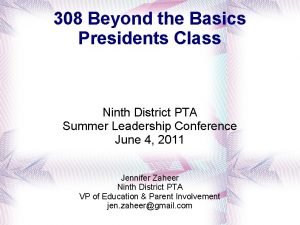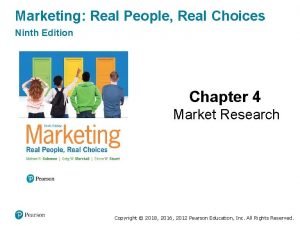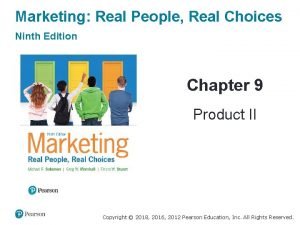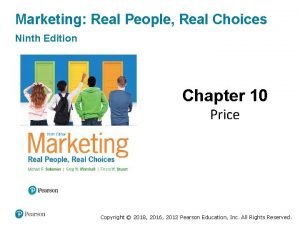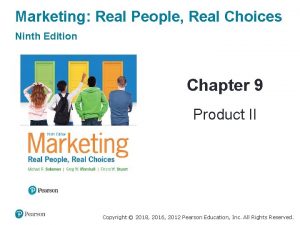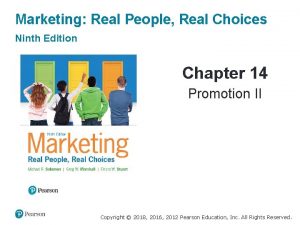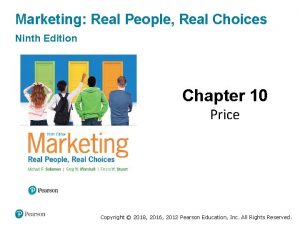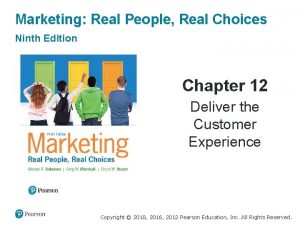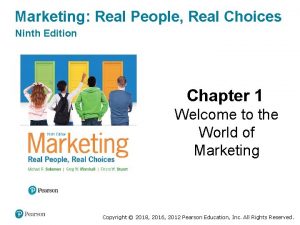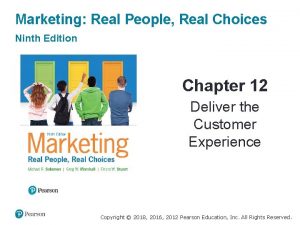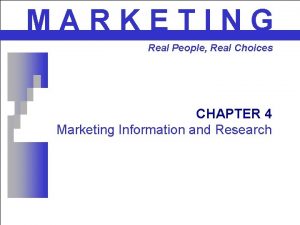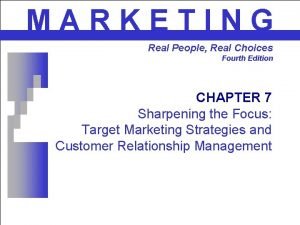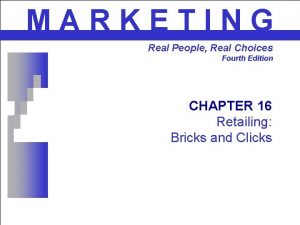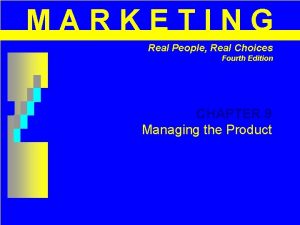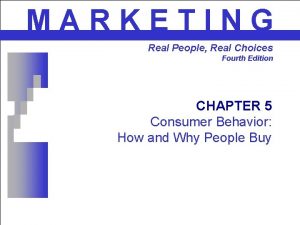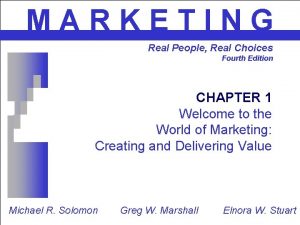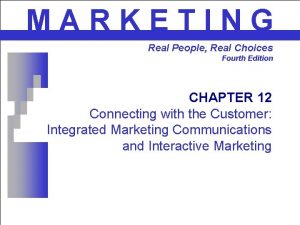Marketing Real People Real Choices Ninth Edition Chapter


































- Slides: 34

Marketing: Real People, Real Choices Ninth Edition Chapter 7 Segmentation, Target Marketing, and Positioning Copyright © 2018, 2016, 2014 Pearson Education, Inc. All Rights Reserved.

Learning Objectives 7. 1 Identify the steps in the target marketing process. 7. 2 Understand the need for market segmentation and the approaches available to do it. 7. 3 Explain how marketers evaluate segments and choose a targeting strategy. 7. 4 Recognize how marketers develop and implement a positioning strategy. Copyright © 2018, 2014, 2012 Pearson Education, Inc. All Rights Reserved.

Real People, Real Choices: Levi Strauss • Which option should be pursued? § Option 1: Focus on the obvious – Levi’s is THE original blue jean. § Option 2: Look at a different definition of originality – Levi’s is as original as you are. § Option 3: Highlight people’s experiences – You wear other jeans but you live your life in Levi’s. Copyright © 2018, 2014, 2012 Pearson Education, Inc. All Rights Reserved.

Target Marketing: Select and Enter a Market • In our modern, complex society, it is a mistake to assume everyone’s needs are the same. • Market fragmentation occurs when diverse interests and backgrounds of individuals create greater diversity in needs and wants. § Technological and cultural advances have fueled growing fragmentation of markets. § Consider the choice you made as a consumer of higher education … Copyright © 2018, 2014, 2012 Pearson Education, Inc. All Rights Reserved.

Figure 7. 1 Steps in the Target Marketing Process Copyright © 2018, 2014, 2012 Pearson Education, Inc. All Rights Reserved.

Step 1: Segmentation • Segmentation is the process of dividing a larger market into smaller pieces based on meaningful, shared characteristics. § Useful in both consumer and B 2 B contexts § Many different dimensions, or segmentation variables, that marketers can utilize Copyright © 2018, 2014, 2012 Pearson Education, Inc. All Rights Reserved.

Figure 7. 2 Segmenting Consumer Markets Copyright © 2018, 2014, 2012 Pearson Education, Inc. All Rights Reserved.

Segmenting by Demographics: Age and Generational Marketing • Children • Teens and Tweens • Generation Z § Born after 1994 • Generation Y § aka Millennials or Echo Boomers § Born between 1979 and 1994 Copyright © 2018, 2014, 2012 Pearson Education, Inc. All Rights Reserved.

Age and Generational Marketing • Generation X (born between 1965 and 1978) § Has entrepreneurial reputation, views home as an expression of individuality • Baby-boomers (born between 1946 and 1964) § Key segment due to their size and earnings, willing to invest money, time, and energy to maintain youthful image • Mature consumers § Focus on lifestyle factors, such as mobility Copyright © 2018, 2014, 2012 Pearson Education, Inc. All Rights Reserved.

Segmenting by Demographics: Gender • Many products appeal to one sex or the other § Metrosexual: A straight, urban male who is keenly interested in fashion, home design, gourmet cooking, and personal care. SHE beer specifically targets female brew drinkers. Copyright © 2018, 2014, 2012 Pearson Education, Inc. All Rights Reserved.

Segmenting by Demographics: Family Life Cycle • Family needs and expenditures change over time. § As families move through stages, different product categories ascend or descend in importance. § Even if importance is constant, needs within category may change (e. g. , furniture). What purchase categories would be of rising importance for young newlywed couples? Expectant parents? Empty nesters? Copyright © 2018, 2014, 2012 Pearson Education, Inc. All Rights Reserved.

Segmenting by Demographics: Income and Social Class • Income § Strongly connected to buying power • Social Class § Upper class, middle class and lower class § Many consumers buy according to an image they’d like to portray, not their actual level. § For instance, “easy credit” may lead consumers to buy cars and homes they can’t truly afford. Copyright © 2018, 2014, 2012 Pearson Education, Inc. All Rights Reserved.

Segmenting by Demographics: Ethnicity • U. S. ethnic and cultural diversity is increasing. § African Americans, Hispanic Americans and Asian Americans are largest groups and growing. § Content marketing establishes thought leadership with specific groups. § Managers practice cultural diversity. Copyright © 2018, 2014, 2012 Pearson Education, Inc. All Rights Reserved.

Segmenting by Demographics: Place of Residence • Geodemography § Combines demographics with geography § PRIZM provides detailed segment profiles by zip code based on geodemography and lifestyle. • Geotargeting § Geographically customized web advertising that feeds local ads to users. § Underscores much paid search advertising on Google and other search engines. Copyright © 2018, 2014, 2012 Pearson Education, Inc. All Rights Reserved.

Segmenting by Psychographics • Uses psychological, sociological, and anthropological factors to categorize customers. § Shared “AIOs” § Best known system is VALS Copyright © 2018, 2014, 2012 Pearson Education, Inc. All Rights Reserved.

Segmenting by Behavior • Categorizes consumers based upon how they act toward, feel about, or use a product § § User status 80/20 rule Long tail concept Usage occasions Copyright © 2018, 2014, 2012 Pearson Education, Inc. All Rights Reserved.

Segmenting B 2 B Markets • Segmentation also useful for B 2 B firms! § Helps B 2 B companies understand needs and characteristics of potential customers • Firms can be categorized based on: § Organizational demographics § Production technologies used § User status Copyright © 2018, 2014, 2012 Pearson Education, Inc. All Rights Reserved.

Segmentation, Not Stereotyping • The idea of segmenting is to identify groups of customers with similar needs. § Allows marketing to be more efficient and more effective • There are many ways by which marketers may segment consumer and business markets. Imagine you have been hired by an off-campus college bookstore as a marketing consultant. What do you think would be the best approach for segmenting their market? Copyright © 2018, 2014, 2012 Pearson Education, Inc. All Rights Reserved.

Step 2: Targeting • The next step is targeting, in which marketers evaluate each potential segment and decide upon which groups of customers they will invest marketing resources. § Selected groups are known as target markets Copyright © 2018, 2014, 2012 Pearson Education, Inc. All Rights Reserved.

Figure 7. 3 Phases of Targeting Copyright © 2018, 2014, 2012 Pearson Education, Inc. All Rights Reserved.

Evaluation of Market Segments • A viable market segment should: § have members with similar wants and needs that are different from those in other segments. § be measureable in size and purchasing power. § be large enough to be profitable. § be reachable by marketing communications. § have needs the marketer can address. Copyright © 2018, 2014, 2012 Pearson Education, Inc. All Rights Reserved.

Develop Segment Profiles • After segments are identified, marketers should develop profiles or descriptions of the typical customers within a segment. § Segment profiles might include demographic, location, lifestyle and product-usage characteristics. Copyright © 2018, 2014, 2012 Pearson Education, Inc. All Rights Reserved.

Figure 7. 4 Choosing a Targeting Strategy Copyright © 2018, 2014, 2012 Pearson Education, Inc. All Rights Reserved.

Customized Targeting Strategy • Customized marketing strategy § Tailoring specific products to individual customers § Common in personal and professional services, and in industrial marketing § Mass customization is the extreme case, which involves modifying a basic product to meet the needs and tastes of an individual consumer. Copyright © 2018, 2014, 2012 Pearson Education, Inc. All Rights Reserved.

Ethical/Sustainable Decisions in the Real World • Candy companies have received scrutiny for advertising directly to children. • A large number of candy companies have announced that they will no longer advertise directly to children. Should candy companies be allowed to advertise directly to children? Copyright © 2018, 2014, 2012 Pearson Education, Inc. All Rights Reserved.

Step 3: Positioning • Positioning is the process by which marketers develop a marketing strategy to influence how a particular market segment perceives a good or service in comparison to the competition. Copyright © 2018, 2014, 2012 Pearson Education, Inc. All Rights Reserved.

Figure 7. 5 Steps in a Positioning Decision Copyright © 2018, 2014, 2012 Pearson Education, Inc. All Rights Reserved.

Positioning Statement • An expression of a product’s positioning that is internally developed and maintained in order to support the development of marketing communication that articulates the specific value offered by a product Copyright © 2018, 2014, 2012 Pearson Education, Inc. All Rights Reserved.

Modifying Positioning Strategies • Repositioning establishes a new position in response to market changes. § Commonly used to change the brand image § Repositioning can breathe life into “retro” brands. Copyright © 2018, 2014, 2012 Pearson Education, Inc. All Rights Reserved.

Bringing a Product to Life: Brand Personality (1 of 2) • Positioning strategies often try to create a brand personality. § A distinctive image that captures a brand’s character and benefits. Copyright © 2018, 2014, 2012 Pearson Education, Inc. All Rights Reserved.

Bringing a Product to Life: Brand Personality (2 of 2) • Brand anthropomorphism § Assigning human characteristics and qualities to a brand § Pillsbury Doughboy is an example Copyright © 2018, 2014, 2012 Pearson Education, Inc. All Rights Reserved.

Figure 7. 6 Perceptual Map Copyright © 2018, 2014, 2012 Pearson Education, Inc. All Rights Reserved.

Positioned for Success • Successful brand positioning should align clearly with the company’s competitive advantage(s). § In turn, marketing mix elements should support a distinctive brand image and value proposition for the target market. Think of your favorite restaurant chain. How would you describe its brand personality? Why? Copyright © 2018, 2014, 2012 Pearson Education, Inc. All Rights Reserved.

Copyright © 2018, 2014, 2012 Pearson Education, Inc. All Rights Reserved.
 Marketing real people real choices 11th edition
Marketing real people real choices 11th edition Marketing: real people, real choices
Marketing: real people, real choices Marketing real people real choices
Marketing real people real choices Levels of analysis psychology
Levels of analysis psychology Mankiw macroeconomics 9th edition
Mankiw macroeconomics 9th edition Human anatomy & physiology edition 9
Human anatomy & physiology edition 9 General adaptation syndrome
General adaptation syndrome Social psychology ninth edition
Social psychology ninth edition Biology ninth edition
Biology ninth edition Laura e berk child development (9th edition pdf)
Laura e berk child development (9th edition pdf) Berk 2013 child development
Berk 2013 child development Abnormal psychology comer 9th edition
Abnormal psychology comer 9th edition Psychology ninth edition in modules
Psychology ninth edition in modules Psychology ninth edition david g myers
Psychology ninth edition david g myers Biology ninth edition
Biology ninth edition Campbell ninth edition
Campbell ninth edition Marketing real people real decisions
Marketing real people real decisions Marketing real people real decisions
Marketing real people real decisions Proactive
Proactive Proactive language vs reactive language
Proactive language vs reactive language Reactive people make choices based on
Reactive people make choices based on Proactive language vs reactive language
Proactive language vs reactive language How do nationalist loyalties shape people's choices
How do nationalist loyalties shape people's choices National loyalties
National loyalties Marketing real people
Marketing real people Ninth commandment catholic
Ninth commandment catholic The sixth and ninth commandments
The sixth and ninth commandments Phos root word examples
Phos root word examples Ramadan information
Ramadan information William blount 9th grade academy
William blount 9th grade academy Lower ninth ward
Lower ninth ward 13 course french classical menu with examples
13 course french classical menu with examples Ninth district pta
Ninth district pta Mis chapter 6
Mis chapter 6 Mis
Mis

